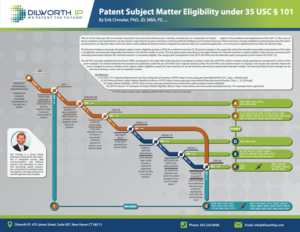Patent Subject Matter Eligibility under 35 U.S.C. § 101
Jul 26th, 2022 by Dilworth IP | News |
Use this link to view and download the infographic:
 Title 35 of the US Code says that an inventor may patent “any new and useful process, machine, manufacture, or composition of matter . . . subject to the conditions and requirements of this title.” But some of these conditions and requirements can be onerous, especially for process inventions involving artificial intelligence and machine learning. These inventions may be ineligible for patenting because the claims are directed to an “abstract idea,” unless the claims recite additional elements that (i) integrate the abstract idea into a practical application, or (ii) amount to significantly more than the abstract idea.
Title 35 of the US Code says that an inventor may patent “any new and useful process, machine, manufacture, or composition of matter . . . subject to the conditions and requirements of this title.” But some of these conditions and requirements can be onerous, especially for process inventions involving artificial intelligence and machine learning. These inventions may be ineligible for patenting because the claims are directed to an “abstract idea,” unless the claims recite additional elements that (i) integrate the abstract idea into a practical application, or (ii) amount to significantly more than the abstract idea.
The below infographic summarizes the patent subject-matter eligibility guidance (PEG) for a claimed invention. The process begins in the upper left, where the broadest reasonable interpretation of the claim is established, and proceeds diagonally downward to the decision nodes in series.
- The five green paths extending to the right indicate the claimed invention is patent eligible.
- The two turquoise paths extending downward indicate the claimed invention is not patent eligible.
- The orange path corresponds to the 2014-2018 PEG.
- The dark-blue path corresponds to the revised 2019 PEG (which remains current as of July 2022).
The 46 PEG examples published by the Patent Office are placed on the right side of the infographic according to analysis under the 2019 PEG, where numbers inside parentheses correspond to claims of the given example.
- An asterisk indicates the example was published under the pre-2019 PEG but it requires analysis under the 2019 PEG.
- One asterisk means no change in the result.
- Two asterisks means the result changed (as shown).
- Details of the subject-matter eligibility analysis for each example can be found by selecting the hyperlinked example number.
- The technical field of each example can be seen by hovering a cursor over an example number.
This article is for informational purposes, is not intended to constitute legal advice, and may be considered advertising under applicable state laws. The opinions expressed in this article are those of the author only and are not necessarily shared by Dilworth IP, its other attorneys, agents, or staff, or its clients.

